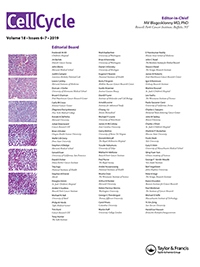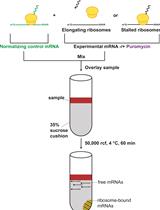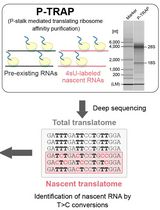- EN - English
- CN - 中文
Ribonucleoprotein Immunoprecipitation (RIP) Analysis
核糖核蛋白免疫沉淀分析
发布: 2020年01月20日第10卷第2期 DOI: 10.21769/BioProtoc.3488 浏览次数: 10406
评审: Khyati Hitesh ShahPooja VermaAnonymous reviewer(s)
Abstract
RNAs and RNA-binding proteins (RBPs) can interact dynamically in ribonucleoprotein (RNP) complexes that play important roles in controlling gene expression programs. One of the powerful ways to investigate changes in the association of RNAs with an RBP of interest is by immunoprecipitation (IP) analysis of native RNPs. RIP (RNP immunoprecipitation) analysis enables the rapid identification of endogenous RNAs bound to an RBP and to monitor time-dependent changes in this association, as well as changes in response to different metabolic and stress conditions. The protocol is based on the use of an antibody, typically an anti-RBP antibody, to immunoprecipitate the RNP complex. The RNA within the immunoprecipitated complex can then be isolated and further studied using different approaches such as PCR, microarray, Northern blot, and sequencing analyses. Among other advantages, RIP analysis (i) measures RNP associations in many samples relatively quickly, (ii) can be adapted easily to different endogenous RBPs, and (iii) provides extensive information at low cost. Among its limitations, RIP analysis does not inform on the specific sites of interaction of an RBP with a given target RNAs, although recent adaptations of RIP have been developed to overcome this problem. Here we provide an optimized protocol for RIP analysis that can be used to study RNA-protein interactions relevant to many areas of biology.
Keywords: RNA-binding proteins (RNA结合蛋白)Background
The post-transcriptional fate of RNA is strongly regulated by its dynamic association with RNA-binding proteins (RBPs) forming ribonucleoprotein (RNP) complexes that govern all aspects of RNA metabolism, including precursor RNA splicing, and RNA modification, folding, translation, stability, transport, and storage (Glisovic et al., 2008). Additionally, alterations in RBP functions have been implicated in many human pathologies, including neurodegeneration (Kang et al., 2014; Ravanidis et al., 2018), immune diseases (Idda et al., 2018; Yoshinaga and Takeuchi, 2019) and cancers (Pereira et al., 2017). Thus, there is immense interest in developing methods to investigate RNPs and identify target RNAs that can illuminate the function of RBPs in physiology and disease. Excellent reviews of the most common methods for RNP analysis are available (McHugh et al., 2014; Cipriano and Ballarino, 2018; Licatalosi et al., 2019).
Originally developed in the Keene laboratory (Tenenbaum et al., 2000; Keene et al., 2006), RNP immunoprecipitation (RIP) analysis is most often used to measure the association of a specific RBP with RNAs in intact cells. The method described here is suitable for most RBPs, but the efficiency is strongly dependent on the quality of the antibodies, the abundance of the RBP analyzed, and the methods to assess bound RNA. In a nutshell, RIP analysis entails the immunoprecipitation (IP) of a specific RBP under mild conditions that preserve the RNP complexes in the IP, whereupon the RNAs present in the RNP complex can be isolated and further analyzed by a range of RNA-detection methods, such as reverse transcription (RT) followed by quantitative PCR (RT-qPCR) analysis (Figure 1A) or other techniques such as Northern, RNA-seq, or microarray analyses (Tenenbaum et al., 2000; Keene et al., 2006; Zhao et al., 2010). RIP analysis is well suited to measure many RNAs at once and to detect changes in binding to RNAs as a function of time or stimulus in a fast and inexpensive way. While this RIP procedure does not reveal the actual site of RBP binding to a target RNA, adaptations of this method including a cross-linking step (crosslinking IP, CLIP) or not (Digestion Optimized-RIP, DO-RIP) do permit the identification of RNA sequences bound by the RBP, although these analyses are often more time-consuming and technically challenging (Nicholson et al., 2017; Lee and Ule, 2018; Wheeler et al., 2018; Lin and Miles, 2019).
In summary, RIP identifies RNAs associated with a given RBP and informs on changes in the intracellular composition of RNPs in response to different stimuli. RIP has been used in many laboratories to identify endogenous RBPs associated with endogenous RNAs in a wide range of cell types. In this protocol, we describe the use of RIP in the human monocytic leukemia line THP-1, although the same protocol can be used for other cell lines.
Materials and Reagents
Note: Please ensure that all reagents and materials are confirmed to be RNase-free. We normally use company-certified RNase-free solutions and materials for RIP assay.
- MicroAmp® optical 384-well reaction plate (Thermo Fisher Scientific, Applied BiosystemsTM, catalog number: 4309849)
- Safe-Lock 1.5-ml Eppendorf Tubes (Eppendorf, catalog number: 0030120086)
- ThermoGridTM rigid strip 0.2-ml PCR tubes (Denville Scientific, catalog number: C18064)
- Disposable cuvettes, 1.5-ml (Stockwell Scientific, catalog number: 2410)
- Protein A-Sepharose® (PAS) preswollen beads (GE Healthcare, catalog number: 17-1279-02)
- Appropriate primary antibody recognising a specific RBP of interest. Here we use antibody anti-DRBP76/ILF3 (NF90) as an example (Millipore, catalog number: ABF1070)
- A species-appropriate isotype control. For NF90 RIP, we use normal mouse IgG control (Santa Cruz Biotechnology, catalog number: sc-2025)
- DNase I (RNase-free) (Thermo Fisher Scientific, catalog number: AM2222)
- RiboLock RNase inhibitor (40 U/μl) (Thermo Fisher Scientific, catalog number: EO0381)
- Random primers (100 μM) (Thermo Fisher Scientific, catalog number: SO142)
- dNTP mix (10 mM each) (Thermo Fisher Scientific, catalog number: R0192)
- MaximaTM reverse transcriptase (Thermo Fisher Scientific, catalog number: EP0741) and 5x RT buffer (provided with Maxima Reverse Transcriptase)
- Proteinase K Solution (20 mg/ml) (Thermo Fisher Scientific, catalog number: AM2546)
- Nuclease-free water (Thermo Fisher Scientific, catalog number: AM9930)
- Dulbecco’s phosphate-buffered saline (DPBS) (Thermo Fisher Scientific, catalog number: 100100-15)
- Halt Protease & Phosphatase inhibitor cocktail (100x) (Thermo Fisher Scientific, catalog number: 78442)
- TRIzolTM (Thermo Fisher Scientific, catalog number: AM9738)
- DTT (Sigma-Aldrich, catalog number: 43815)
- UltraPure 1 M Tris-HCl (pH 7.5) (Thermo Fisher Scientific, catalog number: 15567-027)
- 1 M KCl solution (Sigma-Aldrich, catalog number: 60142)
- 1 M MgCl2 solution (Sigma-Aldrich, catalog number: M1028)
- 0.5 M EDTA (Thermo Fisher Scientific, catalog number AM9261)
- 5 M NaCl solution (Sigma-Aldrich, catalog number: 71386)
- 20% SDS solution (Sigma-Aldrich, catalog number: 05030)
- GlycoBlueTM (15 mg/ml) (Thermo Fisher Scientific, catalog number: AM9515)
- KAPA SYBR® FAST ABI prism 2x qPCR master mix (Kapa Biosystems, catalog number: KK4605), or SYBR Green from other vendors
- NonidetTM P-40 (IGEPAL® CA-630, Sigma, catalog number: I8896)
- Chloroform (Sigma-Aldrich, catalog number: C2432)
- Isopropanol (Sigma-Aldrich, catalog number: I9516)
- Ethanol (Sigma-Aldrich, catalog number: 51976)
- Bio-Rad Protein Assay Dye Reagent Concentrate (for Bradford assay) (Bio-Rad, catalog number: 5000006)
- Polysome extraction buffer (PEB) (see Recipes)
- NT2 buffer (see Recipes)
Equipment
Note: Other analogous equipment can be used for this protocol.
- PCR strip tube rotor, mini centrifuge C1201 (Denville Scientific, catalog number: C1201-S [1000806])
- NanoDropTM One spectrophotometer (Thermo Fisher Scientific, catalog number: ND-ONE-W)
- Eppendorf Thermomixer® R (Eppendorf, catalog number: 022670581)
- Refrigerated centrifuge (Eppendorf, model: 5430R)
- SmartSpecTM Plus (Bio-Rad Laboratories, catalog number: 1702525) or another spectrophotometer with 595 nm wavelength
- Tube Revolver/Rotator (Thermo Fisher Scientific, catalog number: 88881001)
- VeritiTM 96-well thermal cycler (Thermo Fisher Scientific, catalog number 4375786)
- QuantStudioTM 5 Real-Time PCR System, 384-well (Thermo Fisher Scientific, catalog number: A28140)
- Cell culture hoods and CO2 Incubator for cell culture
Procedure
文章信息
版权信息
© 2020 The Authors; exclusive licensee Bio-protocol LLC.
如何引用
Martindale, J. L., Gorospe, M. and Idda, M. L. (2020). Ribonucleoprotein Immunoprecipitation (RIP) Analysis. Bio-protocol 10(2): e3488. DOI: 10.21769/BioProtoc.3488.
分类
生物化学 > RNA > RNA-蛋白质相互作用
分子生物学 > RNA > mRNA 转译
您对这篇实验方法有问题吗?
在此处发布您的问题,我们将邀请本文作者来回答。同时,我们会将您的问题发布到Bio-protocol Exchange,以便寻求社区成员的帮助。
Share
Bluesky
X
Copy link













